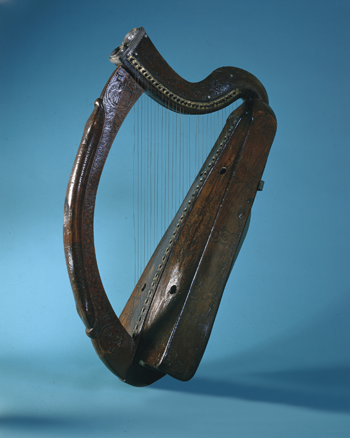The ‘Brian Boru’ harp
Published in Artefacts, Issue 2 (March/April 2014), Volume 22
Above: The ‘Brian Boru’ harp—a fantastic legend is attached to this iconic instrument. (Trinity College, Dublin)
‘To music he was much addicted,’ Joseph C. Walker wrote of Brian Boru, in Historical memoirs of the Irish bards (1786). The ‘exquisite workmanship’ of Brian’s own harp was evidence of his fondness for music, Walker observed, but added a contradictory footnote: ‘The antiquity of this harp is certainly very high, but I cannot think that it is so high as the age of Brian’. The harp had recently (in 1782) been donated to Trinity College by the Right Hon. William Conyngham, with a provenance linking it to Brian Boru. Alternatively known as the ‘Trinity College harp’, it is the oldest harp in Ireland and in 1922 was adopted as the official symbol of the Irish government. Was this the harp of the high-king of Ireland? While the harp or cláirseach did exist in ancient Ireland even before Brian Boru, nonetheless a fantastic legend is attached to this iconic instrument.
After the death of Brian Boru in 1014, his two sons, Tadc and Donnchad, jointly succeeded to the throne. In 1023 Tadc was treacherously slain by Donnchad, who then became high-king of Ireland. By 1064 Donnchad had been dethroned by his nephew Tairdelbach, son of Tadc. According to the story, Donnchad travelled to Rome to seek absolution from the pope for murdering his brother. He brought with him the harp and gold crown of his late father, Brian Boru, and laid them at the feet of the pope. The harp remained at the Vatican until the reign of Henry VIII, when the instrument, along with the title ‘Defender of the Faith’, was sent to the monarch. Henry gave the harp to the first earl of Clanrickard, whose family kept it until the early 1700s, when a lady of the de Burgh family passed it to MacMahon of Clenagh, Co. Clare. After his death, it was bequeathed to Counsellor MacNamara of Limerick. In 1782 the harp was delivered by Chevalier Thomas O’Gorman to Colonel Burton Conyngham, who deposited it in Trinity College, where it remains to this day. The story, initially published in Charles Vallancey’s Collectanea de rebus Hibernicus (1786), was reprinted by Walker in the same year but was deemed questionable, as the anecdotes were ‘originally furnished by Tradition, who is not apt to adhere strictly to truth’.
In Bunting’s 1840 volume, George Petrie’s ‘Memoir of Ancient Irish Harp Preserved in Trinity College’ charges that the story is ‘a clumsy forgery’ fabricated by Chevalier Thomas O’Gorman to ‘raise its antiquity and increase its historical interest’. Eugene O’Curry (1873) suggests that although O’Gorman did communicate the story to both Conyngham and Vallancey, he probably did not invent it. Might there have been a mix-up with the names, and could some parts of the story be true? O’Curry puts forward the possibility that when the harp was given to Clanrickard by Henry VIII it was identified as the harp of Donnchadh Cairbreach O’Brien, the ‘sixth in descent from the great hero of Clontarf’. A misunderstanding occurred whereby the name became Donnchad, son of Brian Boru, after which some person(s) generated a fictional legend. Walker and succeeding historians unanimously agree that the carvings date the harp to the fourteenth or early fifteenth century, and it bears similarities to the ‘Queen Mary harp’ from the same period, held in the National Museum of Scotland.
The many fragments of the harp’s history remain unclear, and similarly the harp itself is a composite of more than one instrument, with various layers of decoration (Armstrong 1904). The earliest depiction (Walker 1786) shows the front pillar separated from the sound box, and in the late nineteenth century a plaster end piece with scroll was added to the base of the pillar (the scroll shape is seen in the national emblem and the Guinness logo). In 1961 the harp was restored by the British Museum to a more original medieval shape. In spite of historical inaccuracies, the name ‘Brian Boru harp’ endures for this symbolic instrument, whose role is to represent the heroic past.
Nancy Hurrell is a harp consultant at the Museum of Fine Arts, Boston, and a member of the harp faculty at the Boston Conservatory.
Further reading
R.B. Armstrong, The Irish and Highland harps (Edinburgh, 1904).
E. Bunting, The ancient music of Ireland (Dublin, 1840).
E. O’Curry, On the manners and customs of the ancient Irish (London, 1873).
J.C. Walker, Historical memoirs of the Irish bards (Dublin, 1786).
















